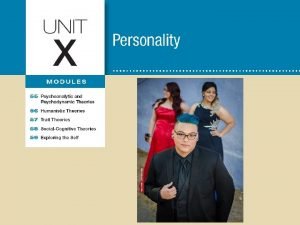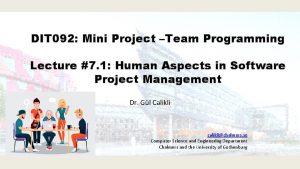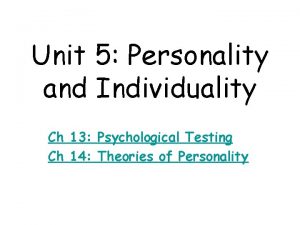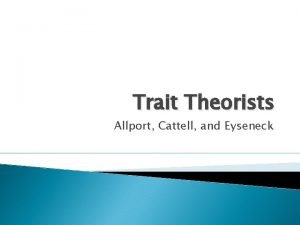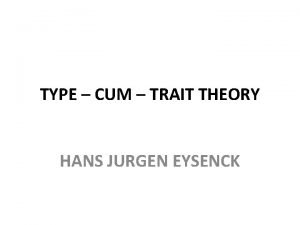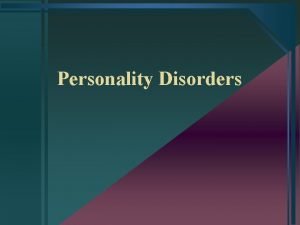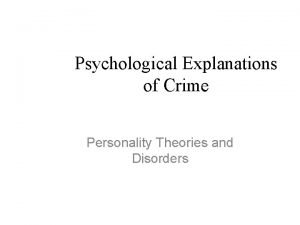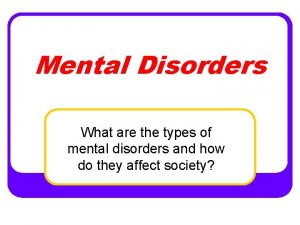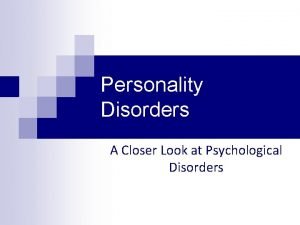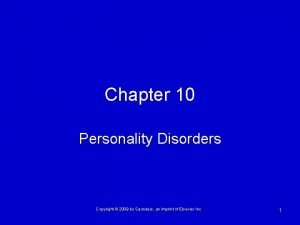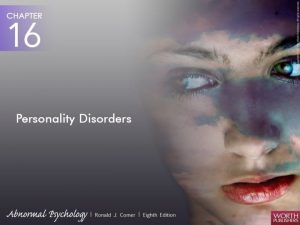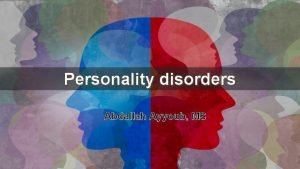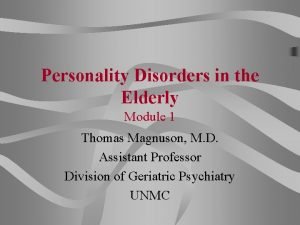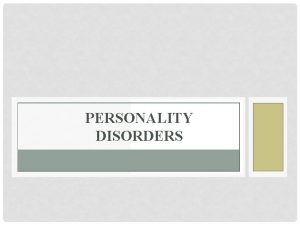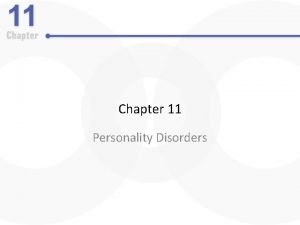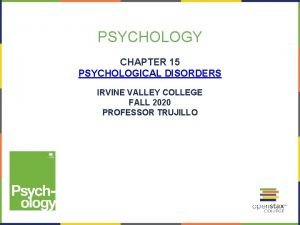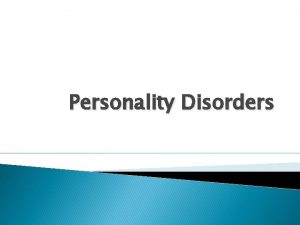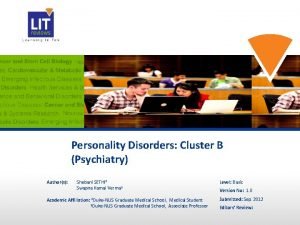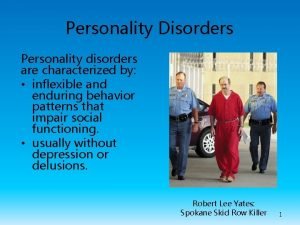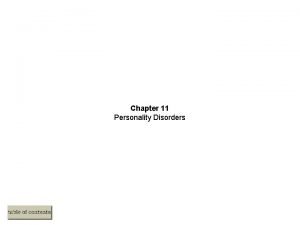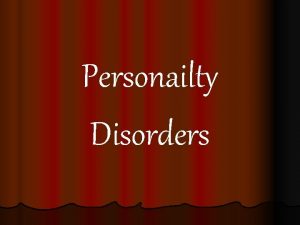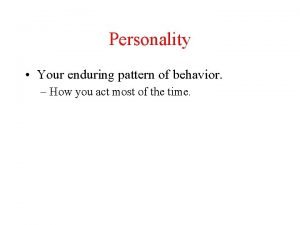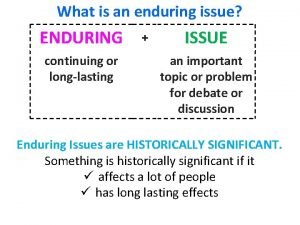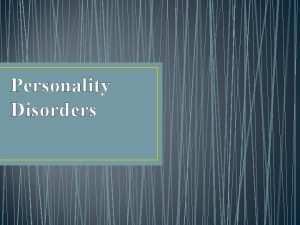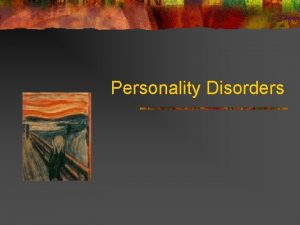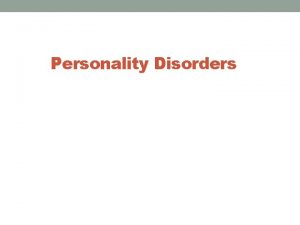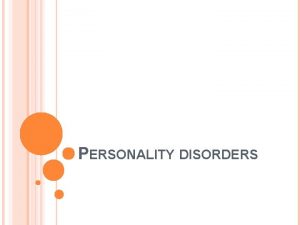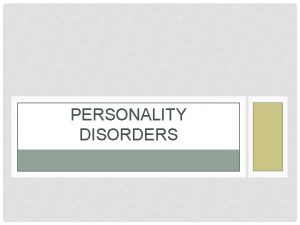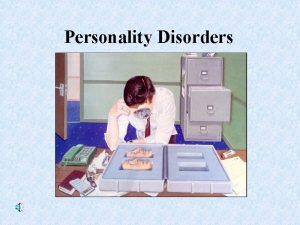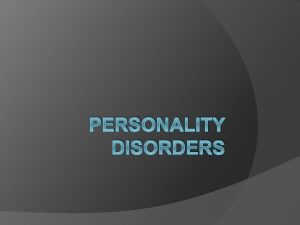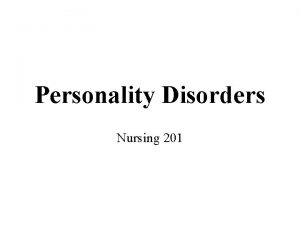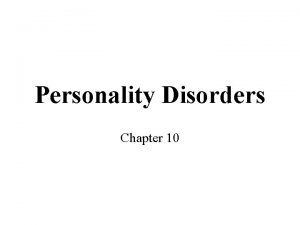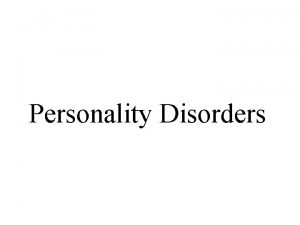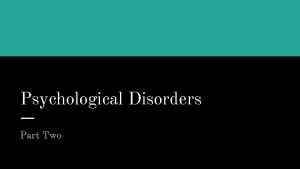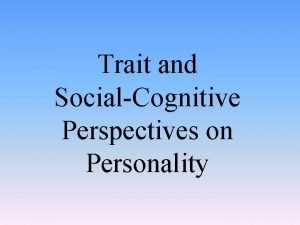PERSONALITY DISORDERS PERSONALITY DISORDERS Personality trait An enduring









































- Slides: 41

PERSONALITY DISORDERS

PERSONALITY DISORDERS • Personality trait: An enduring pattern of perceiving, relating to, and thinking about the environment and others. • Personality disorders: Ingrained patterns of relating to other people, situations, and events with a rigid and maladaptive pattern of inner experience and behavior. • Dating back to adolescence or early adulthood

THE NATURE OF PERSONALITY DISORDERS • Behavior patterns must manifest themselves in at least two of the following four areas: 1. 2. 3. 4. Cognition Affectivity Interpersonal functioning Impulse control

DSM-5 PERSONALITY DISORDER CLUSTERS • The DSM-5 groups the 11 diagnoses into three clusters based on shared characteristics: • Cluster A - The odd and eccentric behaviors • Cluster B - The dramatic and emotional behaviors • Cluster C - The anxious and fearful behaviors

GENERAL CRITERIA FOR A PERSONALITY DISORDER IN SECTION 3

ALTERNATIVE PERSONALITY DISORDER DIAGNOSTIC SYSTEM IN SECTION 3 OF THE DSM-5 • Personality disorders are included in both Section II and Section III of the DSM- 5 due to the complexity of the disorder and various points of view on the disorder. • Section II includes the updated diagnostic criteria. • Section III includes the proposed research model for personality disorder diagnosis where it will receive further study and be revisited in the future. • Within this framework, clinicians would have evaluated all clients on a consistent set of five personality traits.

PERSONALITY DOMAINS IN THE DSM-5 SECTION 3 RATING SYSTEM Copyright © 2014 Mc. Graw-Hill Education. All rights reserved. No reproduction or distribution without the prior written consent of Mc. Graw-Hill Education

DSM-5 SECTION 3 PERSONALITY DISORDER FRAMEWORK

DSM-5 SECTION 3 PERSONALITY DISORDER FRAMEWORK

CLUSTER A PERSONALITY DISORDERS • Cluster A of the personality disorders in DSM-5 include those disorders characterized by eccentric behavior. • In other words, individuals with these disorders show characteristics that might lead others to view them as slightly odd, unusual, or peculiar.

PARANOID PERSONALITY DISORDER • A personality disorder whose outstanding feature is that the individual is unduly suspicious of others and is always on guard against potential danger or harm. • Impossible to trust people • Project blame onto others • Refuse to seek professional help

SCHIZOID PERSONALITY DISORDER • • • Indifference to social and sexual relationships Prefer to be alone No desire to love or be loved Cold, reserved, withdrawn Insensitive to feelings of others

SCHIZOTYPAL PERSONALITY DISORDER • A personality disorder that primarily involves odd beliefs, behavior, appearance, and interpersonal style. • Such individuals lack a clear sense of direction or motivation, and do not have a clear set of standards against which to measure their behavior

SCHIZOTYPAL PERSONALITY DISORDER • • Social isolation Eccentricity Peculiar communication Poor social adaptation • Treatment • Parallels interventions commonly used in treating schizophrenia

CLUSTER B PERSONALITY DISORDERS THESE BEHAVIORS INCLUDE IMPULSIVITY, AN INFLATED SENSE OF SELF, AND A TENDENCY TO SEEK STIMULATION.

ANTISOCIAL PERSONALITY DISORDER • A personality disorder characterized by a lack of regard for society’s moral or legal standards and an impulsive and risky lifestyle. • History • Hervey Cleckley (1941) • Psychopathy • Robert Hare (1997) • Psychopathy Checklist

ANTISOCIAL PERSONALITY DISORDER • The diagnostic criteria in the DSM-5 require that an individual show a pervasive pattern of three out of seven possible behaviors: 1. 2. 3. 4. 5. 6. 7. Failure to conform to social norms Deceitfulness Impulsivity Aggressiveness Disregard for safety of self or others Irresponsibility Lack of remorse

IMPORTANT DISTINCTIONS • There is a difference between antisocial personality disorder and antisocial behavior. • Antisocial behavior • Illegal or immoral behavior such as stealing, lying, or cheating • Criminal • A legal term, not a psychological concept

PERSPECTIVES ON ANTISOCIAL PERSONALITY • Biological • Possible genetic causes • Various brain abnormalities

PERSPECTIVES ON ANTISOCIAL PERSONALITY • Psychological • Neuropsychological deficits • Passive avoidance • Response modulation hypothesis

TREATMENT OF ANTISOCIAL PERSONALITY DISORDER • Problems of working with these individuals • Seeming lack of motivation to change • Tendency toward deception and manipulation • Lack of deep or lasting emotion

BORDERLINE PERSONALITY DISORDER • Pervasive pattern of poor impulse control and instability in mood, interpersonal relationships, and self-image • BPD’s central feature is that of instability • The way that people with BPD relate to others is termed “splitting”

PERSPECTIVES ON BORDERLINE PERSONALITY • Biological • High heritability • Abnormalities in: • Amygdala and prefrontal cortex • Neurotransmitters and hormones

PERSPECTIVES ON BORDERLINE PERSONALITY • Psychological • • • Emotional dysregulation Distress tolerance Experiential avoidance Childhood neglect or traumatic experiences Marital or psychiatric difficulties

TREATMENT OF BORDERLINE PERSONALITY • Dialectical behavioral therapy • Core mindfulness • Transference-focused psychotherapy

NEEDS INVOLVED IN BASIC PRINCIPLES OF EFFECTIVE TREATMENT FOR CLIENTS WITH BPD • Need for clinicians to: • • Take over a primary role in treatment Provide a therapeutic structure Support the client Involve the client in therapeutic process Take an active role in treatment Deal with the client’s suicidal threats or self-harming acts Be self-aware and ready to consult with colleagues

HISTRIONIC PERSONALITY DISORDER • Exaggerated emotional reactions, approaching theatricality, in everyday behavior. • Show extreme pleasure as the center of attention and who behave in whatever way necessary to ensure that this happens. • They are excessively concerned with their physical appearance, often trying to draw attention to themselves in such extreme ways that their behavior seems ludicrous.

HISTRIONIC PERSONALITY DISORDER • • • Flirtatious and seductive Demand reassurance, praise, approval of others Need for immediate gratification Easily influenced by others Lack analytical ability

NARCISSISTIC PERSONALITY DISORDER • Unrealistic, inflated sense of self-importance and lack of sensitivity to other people’s needs

THEORIES OF NARCISSISTIC PERSONALITY • Freudian • Stuck in early psychosexual stages • Psychodynamic • Empathy • Cognitive behavioral • Maladaptive ideas • Grandiose ideas clash with their experiences of failure

TREATMENT OF NARCISSISTIC PERSONALITY • Most effective approach • Provide reassurance and develop a more realistic view of themselves and other people • People with NPD are difficult to treat • Tend not to have insight into their disorder • Extreme perfectionism can obstruct treatment

CLUSTER C PERSONALITY DISORDERS THAT INVOLVE PEOPLE WHO APPEAR ANXIOUS OR FEARFUL AND MAY SEEM HIGHLY RESTRICTED

AVOIDANT PERSONALITY DISORDER • The individual desires, but is fearful of, any involvement with other people and is terrified at the prospect of being publicly embarrassed

AVOIDANT - THEORIES • Cognitive-behavioral • • • Hypersensitive due to parental criticism Feel unworthy of other people’s regard Expect not to be liked Avoid getting close to avoid expected rejection Distorted perceptions of experiences with others

TREATMENT OF AVOIDANT PERSONALITY • Cognitive-behavioral • • Break negative cycle of avoidance Confront and correct dysfunctional attitudes and thoughts Graduated exposure to social situations Learn skills to improve chance of intimacy

DEPENDENT PERSONALITY DISORDER • The individual is extremely passive • Tends to cling to other people to the point of being unable to make any decisions

OBSESSIVE-COMPULSIVE PERSONALITY DISORDER • A personality disorder involving intense perfectionism and inflexibility manifested in worrying, indecisiveness, and behavioral rigidity. • OCPD is a disturbance of personality, not a disturbance involving anxiety or even out-of-control behaviors • OCPD do not experience obsessions and compulsions. OCPD refers to this rigidly compulsive personality tendency and also obsessive concern with perfectionism.

OBSESSIVE-COMPULSIVE DISORDER • Sense of self and self-worth in terms of work productivity • Pathological personality trait - Rigid perfectionism • Quality of perseveration

THEORIES OF OBSESSIVE-COMPULSIVE • Freudian • Fixation at anal psychosexual stage • Cognitive-behavioral • Unrealistic standard of perfection • Ruminative tendency • Metacognitive interpersonal therapy • Think about their thinking

BIOPSYCHOSOCIAL PERSPECTIVE • Disorders represent: • Mix of long-standing personal dispositions and behavior patterns • Disturbances in identity and interpersonal relationships

THANKS
 Trait theory of personality
Trait theory of personality Personality.traits
Personality.traits Mc craes
Mc craes Openness personality trait
Openness personality trait Trait theories of personality _____.
Trait theories of personality _____. What is personality assessment
What is personality assessment Trait theorists are generally more interested in
Trait theorists are generally more interested in Hans eysenck trait theory
Hans eysenck trait theory Grit personality trait
Grit personality trait Personality trait disorder
Personality trait disorder Cluster b personality disorders
Cluster b personality disorders Cluster a personality disorders
Cluster a personality disorders Paranoid personality disorder
Paranoid personality disorder Cluster b personality disorders
Cluster b personality disorders Avoidant personality traits
Avoidant personality traits Carla homulka
Carla homulka Weird wild wacky personality disorders
Weird wild wacky personality disorders Cluster c personality disorders symptoms
Cluster c personality disorders symptoms Dsm v personality disorders
Dsm v personality disorders Cluster c personality disorders
Cluster c personality disorders Body dysmorphia irvine
Body dysmorphia irvine Type c personality disorder
Type c personality disorder Cluster b personality disorder
Cluster b personality disorder Group c personality disorders
Group c personality disorders Cluster c
Cluster c Enduring skills definition
Enduring skills definition Lasting service is the service to uplift all
Lasting service is the service to uplift all Dbt accepts
Dbt accepts Enduring pattern
Enduring pattern 1 peter 3 enduring word
1 peter 3 enduring word Essential understanding examples
Essential understanding examples Enduring pattern
Enduring pattern Enduring issues essay
Enduring issues essay Enduring love plot
Enduring love plot Transitory service intensifiers
Transitory service intensifiers Define conflict enduring issue
Define conflict enduring issue Salleh japar
Salleh japar What is an enduring issue
What is an enduring issue An individual's enduring tendency to feel
An individual's enduring tendency to feel Enduring pattern meaning
Enduring pattern meaning Enduring issues essay examples
Enduring issues essay examples Enduring pattern of behavior
Enduring pattern of behavior

